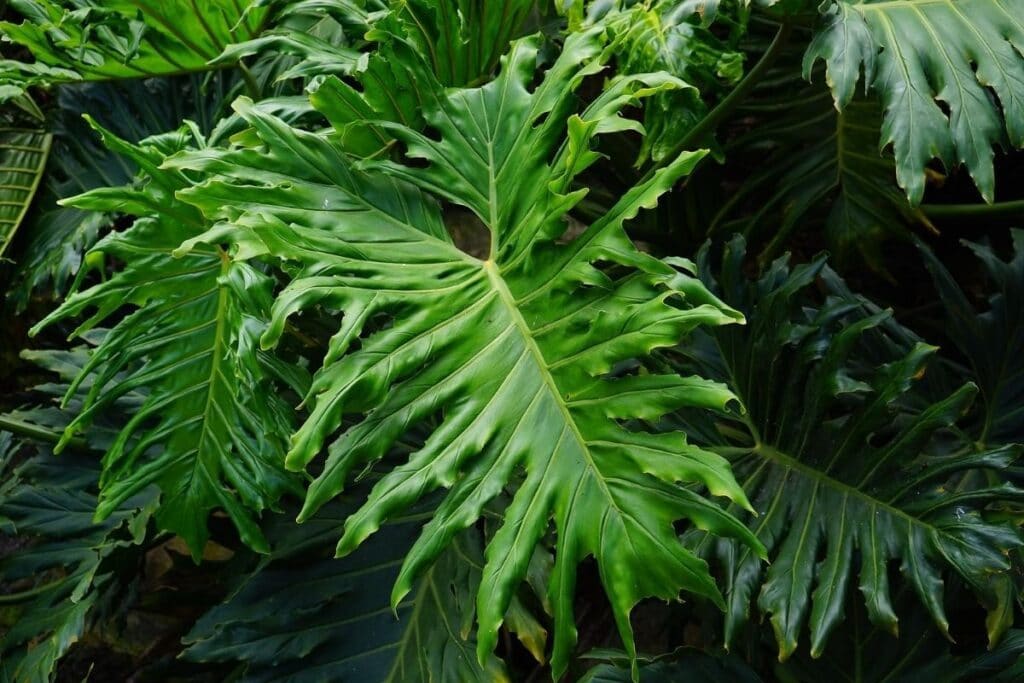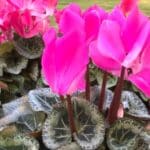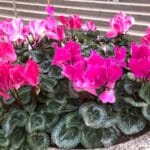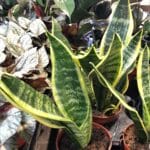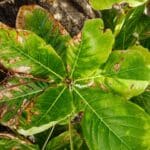These easy to care for plants are a perfect choice for many people wanting to spruce up their homes. With their interesting, broad leaves, hope philodendrons are sure to give any space a lovely, tropical vibe. See here how you can get the most out of this beautiful plant while keeping it thriving.
What is a Hope Philodendron?
Hope philodendron (Philodendron selloum) hails from the extensive plant family of aroids. It is a beautiful tropical plant that originated in South America.
The genus name Philodendron comes from the Greek words ‘philo’ and ‘dendron’ which means tree loving. Hope philodendron is also known as lacy tree philodendron and horsehead philodendron (1). Philodendron selloum is a synonym of Philodendron bipinnatifidum (2).
Like most philodendron species, hope philodendron is grown for their foliage. They are prized for their deeply lobed, evergreen leaves that can reach up to 1.5 meters long.
The large, shiny, green leaves grow outward from a small base. Because of their interesting silhouette, the leaves are also grown as a cut foliage. When allowed to grow and mature, the base of the plant develops into a trunk-like structure.
Does Hope Philodendron Bloom?
Hope philodendron flowers are hard to come by especially when they are grown indoors. If you are a new owner of a hope philodendron plant, you will have to wait 15-16 years before your plant reaches maturity and bloom. But when they do, the flowers are borne in a white spadix inflorescence hidden under the broad leaves (3).
Is Tree Philodendron Toxic?
While they are beautiful, most species of Philodendron are toxic to both humans and pets. These plants have calcium oxalate crystals that can cause skin irritation and swelling of the tongue and throat when ingested (4). This is why you need to be careful when growing tree philodendron as a houseplant.
How to Take Care for Philodendron Selloum
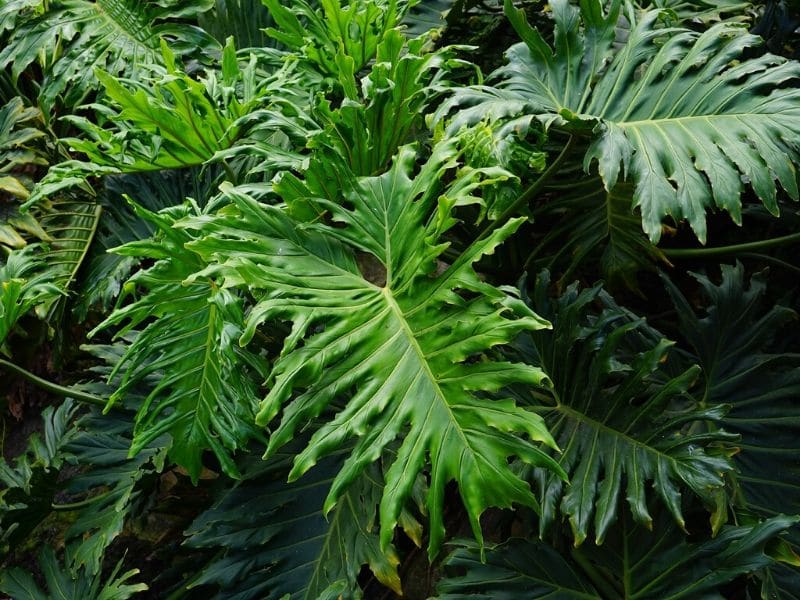
Hope philodendrons are a hardy species but caring for them can be due for some problems. Keep your philodendron plants thriving beautifully all year round with these care tips.
Sunlight
Philodendron hope selloum prefers bright indirect light but can tolerate partial shade. Place them near a window where they can receive filtered sunlight or dappled shade outdoors.
Avoid exposing them to direct sun light, especially during the hottest part of the day, as this can scorch the leaves. Rotate the plant occasionally to ensure even growth and prevent leggy growth.
Water
Water Philodendron selloum moderately, allowing the top inch of soil to dry out between waterings. During the growing season (spring and summer), water them when the soil feels slightly moist to the touch.
Reduce watering frequency in fall and winter when growth slows down. Avoid overwatering, as this can lead to root rot. Water directly onto the soil, avoiding wetting the leaves to prevent fungal diseases.
Temperature and Humidity
For optimum growth, Hope Philodendrons need to be in average to warm temperatures between 70-85oF (21-29oC). Because their leaves are thinner than other philodendrons, hope philodendrons will require humid environments. Misting occasionally during winter months will help with the drier air.
Growing/Potting Media
Philodendron selloum thrives in well-draining, fertile soil with organic matter. Use a rich, peat-based potting mix with added perlite or coarse sand to improve drainage. Ensure the soil is airy and loose to promote healthy root growth.
Avoid soggy soil, heavy or compacted soils, as they can lead to waterlogging and root rot.
Fertilizer
Hope philodendrons are moderate feeders and do not require a lot of fertilizer but inadequate fertilizer can cause the leaves to turn yellow.
On the other hand, too much plant food can cause salt buildup in the soil and lead to leaf tips burning. Feed them from spring to fall with a high nitrogen foliage plant fertilizer to keep the leaves green and healthy. In winter, feed them once every 6 weeks (1).
Pruning
Although they can shed dead, older leaves on their own, hope philodendrons can benefit once in a while from pruning. Pruning can help in giving your hope philodendron plant a bushy appearance. Older philodendrons also develop a ‘trunk’ and pruning the lower leaves can give it a tree-like appearance.
Keep in mind to wear gloves when pruning your hope philodendron to prevent skin contact with the irritating sap.
Common Pests and Diseases
Similar to other types of Philodendron, Hope philodendrons are susceptible to aphid and mealybug infestation. These pests can cause rumpled new growth, yellow spots, and a cottony white residue on the leaves and stems. They can be rid of by rinsing or picking off with tweezers or cotton swabs dipped in alcohol. Spraying with insecticidal soap can also help with these pests. (1).
Bacterial blight and root rot can also infect hope philodendrons. Bacterial blight causes dark green spots on the leaves that eventually rot and die.
To prevent bacterial blight infection, keep the leaves dry and avoid overhead watering. Remove infected leaves to prevent spreading of the infection (5). Prevent root rot by avoiding overwatering of the plant.
Washing the leaves of your Hope Philodendron once a month with mild soap and water will help give it a foliage wax-free shine. Make sure to not get soapy water on the potting soil.
How to Propagate Hope Philodendron
Hope Philodendron can be propagated by seed, leaf stem tip cuttings, or through basal offshoots. For stem cuttings, cut a portion of the stem tip with at least two intact leaf nodes. This is important as this will be where the roots will grow.
You can root the stem cutting in water or directly into soil (4, 5). For basal offshoot propagation, simply separate the offshoot from the mother plant and plant in a separate pot.
FAQs
Can Philodendron Selloum get too much light?
Philodendron Selloum can tolerate a range of light conditions but can suffer if exposed to too much direct sunlight, especially during the hottest part of the day. Prolonged exposure to intense sunlight can cause leaf burn and stress the plant.
Why is my Philodendron Selloum dying?
Several factors can cause a Philodendron Selloum to start dying, including overwatering, underwatering, improper lighting, pests, diseases, or root rot. Assess the plant’s growing conditions, such as water, light, and soil, and adjust as needed to address the underlying issue.
Why is my Selloum turning yellow?
Selloum leaves may turn yellow due to various reasons, such as overwatering, underwatering, nutrient deficiencies, pests, or diseases. Check the soil moisture, adjust watering practices, ensure proper drainage, and inspect the plant for signs of pests or diseases. Providing appropriate fertilizer can also help address nutrient deficiencies.
If you love growing tree philodendron, you’d also want to own a Monstera deliciosa plant as their foliage looks very similar.
For a more detailed guide, check this how to care for philodendron article.
References
Reference List
(1) Pleasant B. “The Complete Houseplant Survival Manual: Essential Gardening Know-how for Keeping (Not Killing!) More Than 160 Indoor Plants”. Storey Publishing. 2012. PP 230-231
(2)Philodendron selloum K.Koch. The Plant List Version 1.1. 2013. (online)
(3) Wilkinson S. “Philodendrons in Bloom” Lewis Ginter Botanical Garden. 2016. (online)
(4) Nelson L.S., Balick M.J. “Handbook of Poisonous and Injurious Plants”. Springer Nature. 2020. P 231.
(5) DelPrince J.M. “Interior Plantscaping: Principles and Practices”. Cengage Learning. 2013. PP287-290.
Close

